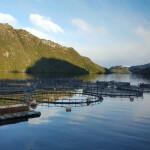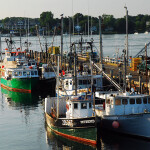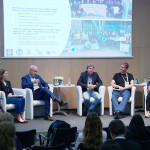Latin American governments must take a more preponderant role in helping to introduce, drive and encourage diversification of the aquaculture sector throughout the region, according to several leading market observers speaking at the Latin American Summit for Fishing and Aquaculture Sustainability.
The conference was hosted by COMEPESCA, the Mexican Council for the Promotion of Seafood Consumption and Aquaculture Products, and took place in an online-only format at the end of October.
According to Carlos Wurmann, who serves as the executive director of aquaculture and fisheries consulting firm Award and board member of the national strategic aquaculture program at Corfo – the Chilean government’s productive investment agency – Latin America needs to drastically increase its investment in the development and incorporation of technologies. Greater private sector participation is necessary, but the role of the state is “fundamental,” he said during the “The Future of Aquaculture in Latin America” panel at the conference.
The state plays a central role in facilitating and promoting aquaculture development, helping to decrease risk in diversification processes and increasing competitiveness and sustainability, Wurmann said. Private enterprise’s vocation is not to engage in highly speculative or risky processes that can last for many years, Wurmann said, but governments can support and drive the development of small-scale aquaculture while also incorporating large-scale projects with a high technological, strategic focus, as well as those projects that help to open new spaces and areas to farming.
Wurmann, who for several decades has served as a fishing expert consultant for international organizations such as the World Bank, the OECD, and the United Nations’ Food and Agriculture Organization, called on the state to provide adequate governance and organizational structure for aquaculture development in order to generate long-term vision and objectives that guide and concentrate developmental processes. He pointed to the need to define policies and strategies and provide leadership in reaching the strategic vision in partnership with all stakeholders.
In Latin America, countries currently work more with short-term vision, and there are problems in governance, sustainability, and productive models, with a moderate level of incorporation of technology, and a low level of financing alternatives and investment in research, development, and innovation (R&D+i), he said. What little innovative capacity exists is poorly organized, he noted, hurting the region’s competitiveness and future development perspectives.
Latin America’s aquaculture sector totaled 3.1 million tons of production in 2018, collectively valued at USD 17.2 billion (EUR 14.2 billion). But growth has slowed in the last five years to 5.6 percent cumulative per year, compared to 17.2 percent growth in the decade spanning 2000 to 2010. There is a high concentration of aquaculture production in few countries – Chile, Brazil, Ecuador, and Mexico – placing too many eggs in the same basket with few species: shrimp, salmonids, mussels, and tilapia – and this is expected to continue for the next 10 to 20 years, Wurmann said.
Countries such as Mexico and Brazil – which has more than 8,000 kilometers of coastline – have created significant incentives to increase domestic production and decrease imports. And the market appears to already exist – both countries import large amounts of seafood products. Wurmann said those two countries have enormous potential to increase their aquaculture productios, along with Peru. And while Chile’s aquaculture industry is more developed, Wurmann said it still has room for growth.
Wurmann said he expects both growing national and international market demands for seafood to increase competition, requiring improved quality, traceability, sanitary conditions, consistency, and sustainability. A significant effort is needed to diversify production – species, technology, and regions – in the next few decades, he said.
Using current forecasting models, regional aquaculture production is expected to increase to 4.5 million tons to 4.6 million tons by 2030, if current trends continue, with a lower growth rate for the region when compared to previous decades. Latin America is expected to increase farming production about 50 percent per decade – approximately 4 percent a year – but Wurmann said this could easily increase with better organization, higher investment in R&D+I and other enabling activities.
Wurmann listed two disruptive technologies as presenting great opportunity, or a possible threat to Latin American aquaculture, depending on how broadly they are adapted: recirculation technology and advances in oceanic farming. Latin America could lose its relative competitivity when it came to these technologies in coming years if it doesn’t continue to innovate, he said. But small-scale fish-farming shouldn’t be ignored either, according to Wurmann, as it is expected to contribute more to meeting domestic demand and create jobs and revenue in rural areas in coming years. Currently, it represents about 50 percent of regional demand, contributing significantly to food security, he said.
Another expert on aquaculture, Sergio Guevara – who is credited with starting the first offshore Mediterranean mussel farm in North America – said that 10 years ago, it was difficult to get a fisher in Latin America to turn to aquaculture. However, he said current social conditions may be more conducive, as there is currently increasing pressure from coastal inhabitants to access fishing but marine resources are decreasing, leading to social unrest.
He said that there are now several issues favoring aquaculture development: high growth rates, the ability to support higher densities, improved treatments for sickness, and developed markets for proven, “cosmopolitan” species such as the manila clam and Pacific oyster.
Farshad Shishehchian, the president and CEO of Singapore-based aquaculture industry supplier Blue Aqua, agreed with Guevera. He pointed to studies projecting that by 2030, 62 percent (94 million tons) of the world’s seafood will be farm-raised, while only 38 percent (58 million tons) will be be wild-caught.
“Limitation is the mother of innovation,” Shishehchian said.
Given high electricity costs, coupled with water, land and supply scarcity, “intensification is the only answer,” Shishehchian said.
“You need good production – that is the future of aquaculture,” he said
However, Shishehchian dismissed recirculating aquaculture systems (RAS) as not being financially viable.
“Expensive systems for food security don’t work,” he said.
Pointing to super-intensive farms in Singapore and Oman as examples, Shishehchian said a potential model of viability for Latin America’s aquaculture sector is are so-called circular economy systems, which uses technology such as automation and artificial intelligence to created interconnected components that utilize all resources, including waste, created by an aquaculture system.
“It’s not rocket science, but you need tuning – what I call environmental modulation,” he said. “It doesn’t need to be a beautiful system, but sufficient, with simple equipment. The point is productivity.”
Photo courtesy of Aqua-Spark







